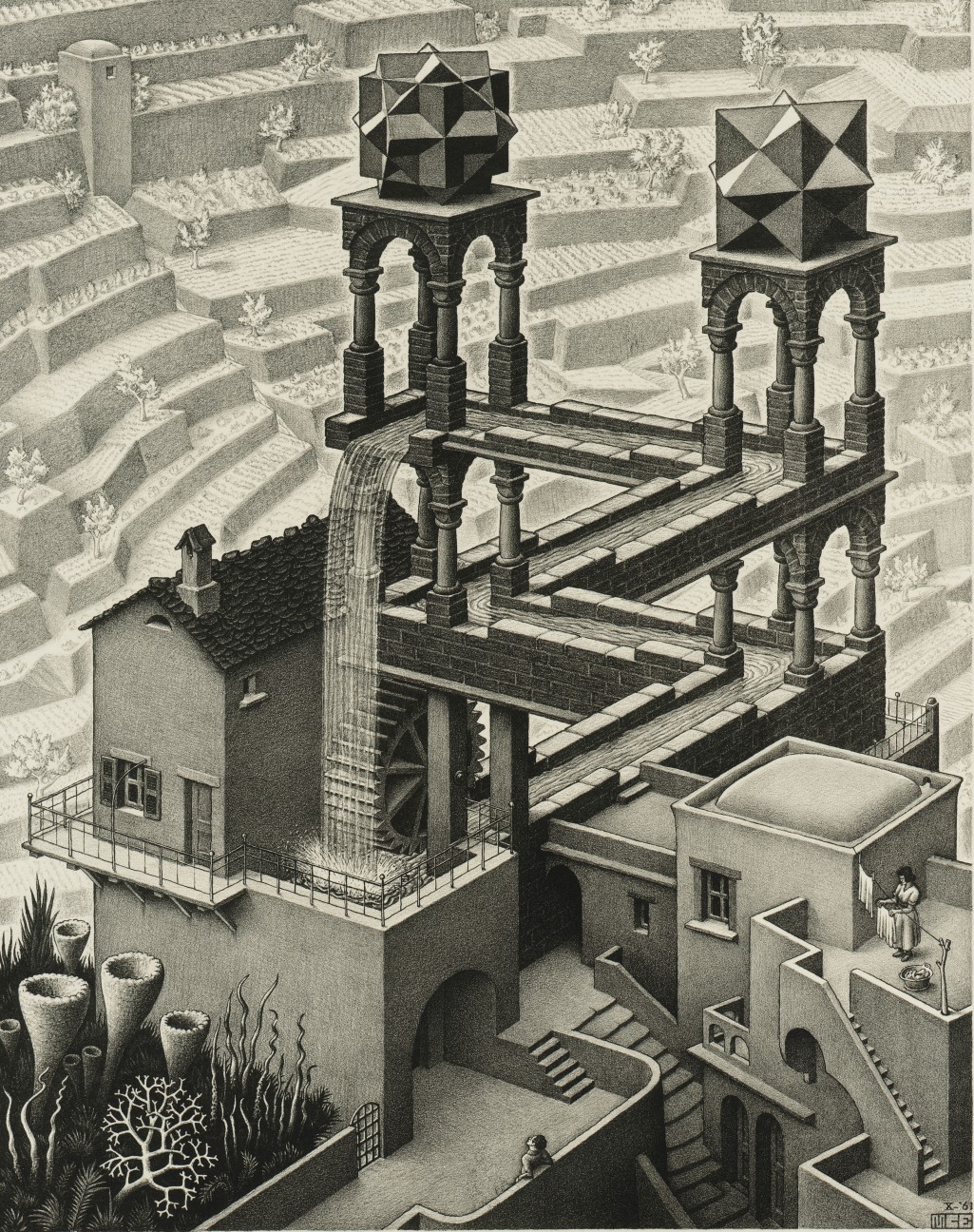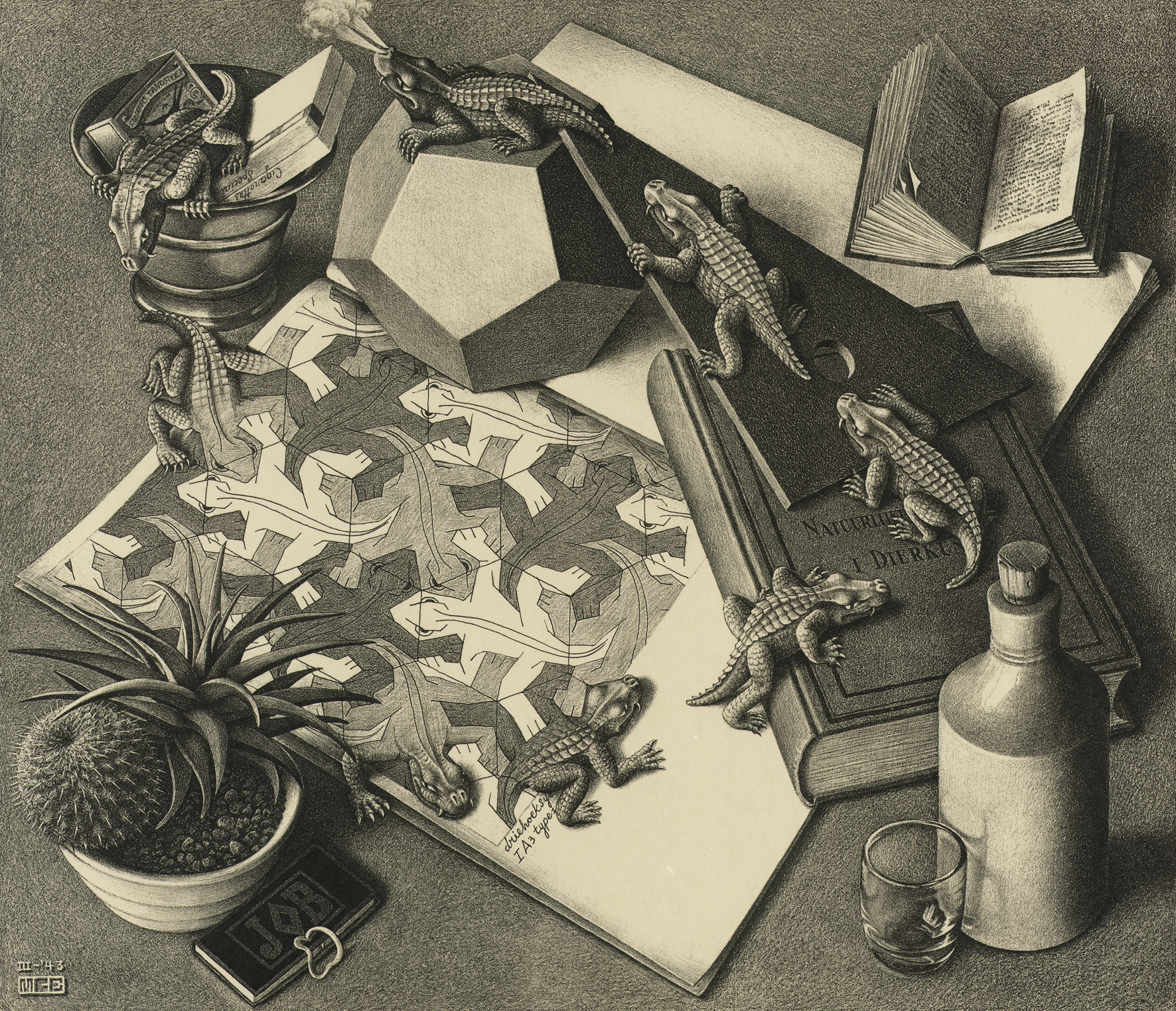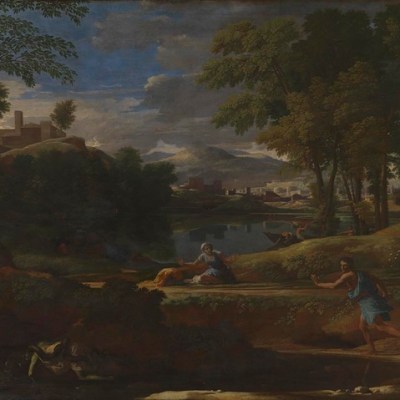From the December 2015 issue of Apollo: preview and subscribe here
Maurits Cornelis Escher (1898–1972), doyen of the student-bedroom wall and the prog-rock album cover: technical master and surrealist visionary, or Jack Vettriano for people who like crossword puzzles? Both, conceivably. That’s where we are, anyway, in the realm of paradox and warped reflection. And this exhibition, shown first at the Scottish National Gallery of Modern Art and now to be found at the Dulwich Picture Gallery, is a confrontation with the deeply familiar and the persistently mysterious.
Few 20th-century works are as omnipresent as, for instance, Ascending and Descending (1960), perhaps Escher’s signature image, in which dour, cowled figures trudge up and down the same, impossibly looped, staircase. But that very familiarity makes coming to it and trying to see something new strangely rewarding. Its contradiction rests on the dimensionally warped staircase (derived from the speculations of the mathematician Roger Penrose), but also in its uneasy tension between playful teasing of the eye and grim dystopia. Escher wrote cheerily of the resting figures he had dotted here and there, ‘no doubt sooner or later they will be brought to see the error of their non-conformity.’ Sooner or later – but it’s hard to imagine any of these scenes have a past or a future. They are curiously detached from time. (1960? That late?)
The assumption that we know Escher’s work produces other rewarding estrangements, particularly in the less-known early work. Progressing towards the meticulous isometric landscapes, altered perspective, and disturbing tessellations of his later career, in the 1920s and ’30s Escher produced attractive modernist – perhaps faintly vorticist – woodcuts of Mediterranean towns, and obsessive studies of geometric Islamic tiles. There is a literal, if not psychological, darkness to the work from the start, not solely due to the harsh contrasts inherent in woodcut. It’s always a solar eclipse in Escher-world. Jumbled roofscapes have seen the error of their non-conformity and become oddly coherent.
Escher himself, always serious and Shoreditch-bearded, stares back at us from several works. Most hypnotic is an intense woodcut of 1923, with cuts radiating from fierce starburst eyes. More often, the material world in orbit around him – the pens and twists of string on his desk, the cigarette papers and bottle caps and toothpaste – enters the picture. The boundary between studio and picture is regularly toyed with – most famously in Drawing Hands (1948), in which a half-finished study of a hand holding a pen is halfway through finishing its mirror image, and being finished by it. Even without the small vitrine of tools and actual cut woodblock, we can form a broad sense of the man in his room, and his technique. How maddeningly, eye-crossingly difficult it must all have been: hard sums and endless planning, tiny cuts, trial and error, the patient mastering of technique after technique. This and much other archival material from the collection at the Gemeentemuseum Den Haag is one of the great strengths of a superb show – a good deal of it has never been seen before in Britain.
But where did these fantastical micro-universes and the pedantic rendering of nonsense come from? We could begin with the enigmatic lizards or reptiles that appear again and again. In Development II (1939), lizards boil outwards from a vortex of hexagons. In Reptiles (1943), cute yet nasty crocodilian creatures march off the paper, through a mirror, and back again. Those dates, ’39, ’43 – it’s tempting to draw political allegories from these cold-blooded creatures spilling over their frontiers. But no, it’s not that, or anything else, says Escher. The lizards represent nothing at all. What about the geometric forms that cap the impossible waterwheel structure in Waterfall (1961)? ‘The two polyhedra on the top of two towers have no symbolic meaning whatever. I put them there because I like them.’
Pleasing himself was Escher’s primary intention. He worked for his own satisfaction, and found it tiresome to be questioned about deeper significance. What about mathematics? Again, no. Escher’s knowledge of maths was ‘limited and pragmatic’; it was just a tool for getting the effects he wanted. Relationship to his surrealist contemporaries? None to speak of. He was apparently uninterested in money. Success and popularity within his lifetime came to Escher as a massive inconvenience – he kept raising the price of his prints to drive away those pesky buyers, but it never worked.
This opacity could be admirable in its purity – even surrounded by commerce and with offers from the Rolling Stones to design album covers (‘Who is this Jagger?’), he kept doing his own thing. Or is it infuriating? Both, conceivably. One is left with the impression of an artist trying to fend the world away, and that impression strengthens as the 1930s go on. Does his study bleed out into the world, or is he making its own self-contained world? ‘I am interested in patterns with “motives” getting smaller and smaller until they reach the limit of infinite smallness,’ Escher wrote to the mathematician H.S.M. Coxeter in 1958. He was an artist looking for his own vanishing point.
‘The Amazing World of M.C. Escher’ is at the Dulwich Picture Gallery, London, until 17 January 2016





